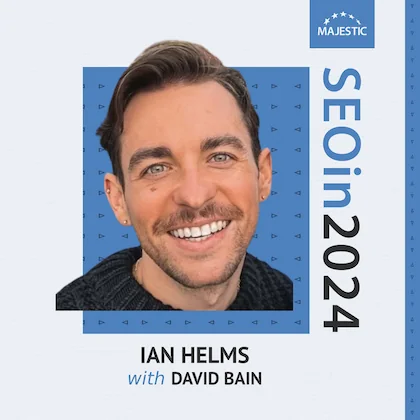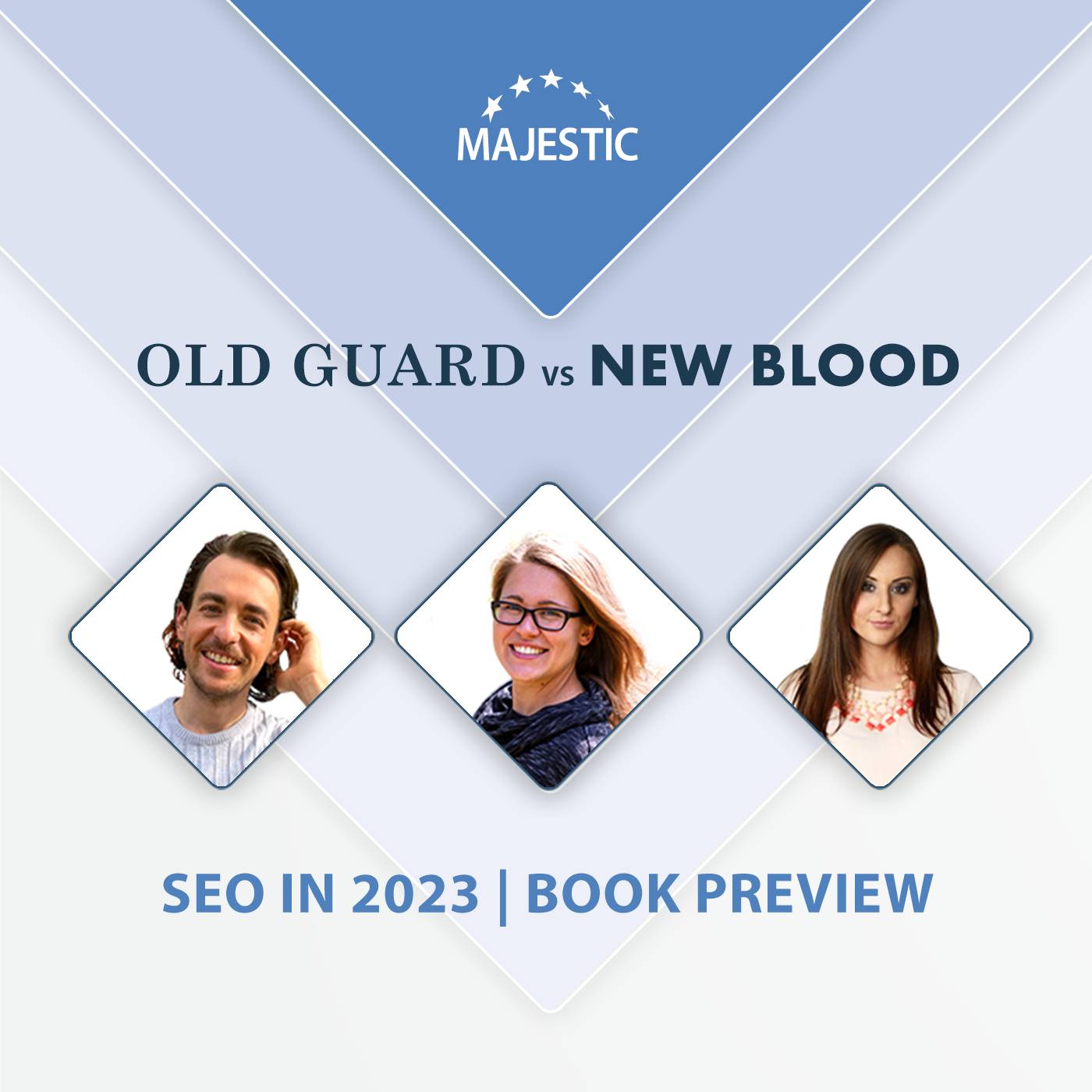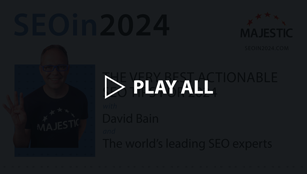-
Site Explorer
- Majestic
- Summary
- Ref Domains
- Backlinks
 New
New Lost
Lost- Context
- Anchor Text
- Pages
- Topics
- Link Graph
- Related Sites
- Advanced Tools
- Author ExplorerBeta
- Summary
- Similar Profiles
- Profile Backlinks
- Attributions
- Compare
-
Link Tools
- My Majestic
- Recent Activity
- Reports
- Campaigns
- Verified Domains
- OpenApps
- API Keys
- Keywords
- Keyword Generator
- Keyword Checker
- Search Explorer
- Link Tools
- Bulk Backlinks
- Neighbourhood Checker
- Submit URLs
- Experimental
- Index Merger
- Link Profile Fight
- Mutual Links
- Solo Links
- PDF Report
- Typo Domain
- Free SEO Tools
- Support
Get better at using AI
Ian says: “AI doesn’t need to get better – SEOs and marketers need to get better at using AI and understanding its limitations.”
Is AI going to get better?
“I am optimistic that it will continue to get better and learn and evolve. However, as with everything and considering the way that AI learns from existing information and even from itself, it has lots of limitations, lots of bias, and lots of nuances that people both fault it for and ignore when they use it in other ways.
People put AI on a pedestal and hold it to a way higher standard than they would another human who’s producing content or writing something. In reality, almost exactly the same mistakes and very similar biases come from human-written content because AI learned from the humans who wrote the content to begin with.”
How do you maximise the potential of the current state of AI?
“Use as many of the tools that are available as possible. Obviously, budget is a barrier to some folks accessing and using AI on a regular basis.
For different projects, and for different initiatives, I use various AI tools to try and learn as much as possible from each one. I try to learn what they’re best at, what they’re not good at, and how to mix them together to create the most positive outcome and the most efficient result in my day-to-day.”
What are some of the tools that you use and what are the strengths and limitations of those tools?
“I predominantly use OpenAI’s ChatGPT-4. I pay for the premium version, which I also use for lots of different things in my personal life. From an SEO perspective, it’s great for things like writing alt text for images. We are testing some new plugins for WordPress that are going to help us write alt text for images but, in the meantime, taking a screenshot of a group of thumbnails has been really successful in optimizing my time when it comes to writing alt text for images. The same is true with things like meta titles and meta descriptions.
Perplexity is another tool that I’ve been using when I am writing content that requires sources, quotes, and citations that certain AI tools don’t have access to or aren’t providing.
I’ve also used Jasper a decent amount. Their chat feature is really nice, and they have a solid dashboard when it comes to organising the content and projects that you’re working on. I’ve used Rytr, and DALL-E for pictures.
I’ve done a few versions of data analysis with different AI tools to varying degrees of success. I don’t necessarily always trust AI when it comes to data analysis yet. I’ve had great success with giving it some data and asking it to find commonalities – for example, looking at a spreadsheet and finding commonalities between specific keywords, links, data points, performance reports, etc.
However, when it comes to giving accurate calculations of that data or comprehensive output surrounding all of that, that’s where it seems limited. It will give you a generalisation around some of the terms and topics. For example, if you give it a bunch of keywords and ask it to cluster them, it won’t always give you every single opportunity or option. It might highlight the top 3, and you have to follow up on that.”
Is that an issue with the prompts or with hallucinations?
“I think it’s a bit of both. Part of my advice about getting better at using AI is knowing how to prompt ahead of time to get what you want. That’s a critical component of using AI more effectively.
However, when it comes to numbers in particular, it definitely struggles with giving an accurate response. I’ve given it paid social data before and asked it to help me create an easy-to-digest graph for an executive summary for a report that I’m working on. It doesn’t always create the graph accurately. It doesn’t always correctly take the right numbers from the right columns, and it doesn’t always average the full set of data. Instead, it might take a sample of it
I haven’t fully cracked the code on it. Maybe that’s my own limitation with fully understanding and using its abilities.”
Have you tried making a custom GPT?
“I haven’t. That’s something that I have yet to explore – and there are lots of them out there right now.
What scared me away from creating my own, in the beginning, was that so many people were churning out new GPTs and other tools. I didn’t want to reinvent a wheel that was already being invented somewhere. However, it’s a compelling thought that I might have to explore because you can create custom GPTs that are very task-specific.
One thing that I’ve learned is that, instead of giving a full export from Google Analytics or your keyword research tool, it’s better to slice that data up into the different columns that you want it to focus on. Only provide the data that you truly want to be analysed. Then it will know exactly which column you’re referring to because there are only so many columns it can look at.
That’s something that I have had more success with. In general, if you can be as specific and focused as possible, that’s when you get the best results from leveraging an AI tool.”
Are there any other tips that you can offer on how to work smarter when you’re using AI?
“I saw a tweet from Lily Ray recently mentioning how she used ChatGPT to ask questions that she wasn’t able to easily search in Google. I found it ironic because I know she doesn’t always speak highly about AI and AI tools, but that’s something that I do a lot.
Another use case for which I like to leverage ChatGPT is to help write schema markup for different pages. I’m not super familiar with all of the ins and outs of schema, and I’m currently in a world that’s newer to me, so there are different types of schema markup that I haven’t seen before.
Knowing what’s required, what’s not required, and how to format the different components of the markup properly is something that I’ve never seen explained well in a YouTube video or long-form written document. There are lots of sites that explain schema, but it’s always been a foreign language to me. I learned significantly more about schema markup by asking AI directly about specific examples that I was trying to get into and uncover.
I find the same thing with reviewing other HTML code. If I’m looking for what might be wrong with a particular web page, actually uploading the code and having AI look at it and point out the exact issue has been extremely useful for me.
You can use AI as a bit of a teacher. It’s not just about asking it to do tasks; you can get its opinion on how to do a task more effectively. When I transitioned from the agency world to an in-house role, one of my biggest concerns was not having direct access to all the SEO experts, content marketers, and other folks who I could send a little Slack message to and get a bunch of opinions from. In that way, ChatGPT has been a bit of a work buddy.
I don’t use it to brainstorm very often. I usually have an idea or a thought and I’m just trying to figure out how to take the first step, how to put something into action, or just validate whether or not it’s a good idea. It has enough background knowledge, because of how it’s built, to point me in a positive direction or help me get to that first step.”
How should SEOs incorporate AI into their workflow?
“I use it daily. If I’m being frank, I use it multiple times a day. The interesting part about my current role is that I work in LGBTQ+ media. One thing that AI struggles with, and has a lot of bias and mixed information on, is LGBTQ+ terms – what they mean, the difference between gender and sex, making sure that it doesn’t mix those topics, etc.
We still very much rely on human writers, human experience, and human perspectives to create the content that we’re writing every day. A lot of our sites are news-focused sites, so they’re writing about things that haven’t happened before. It’s cutting-edge, so the AI doesn’t know about it.
Once that moment in time becomes historical, searchable, and more established, I can bring together our content and the top-ranked pages and have AI compare the original article to other top-ranked articles and see what we might be missing. I can also incorporate my personal human experiences into understanding what might be missing, but then use AI to help write meta descriptions and meta titles, identify areas of opportunity for incorporating more EEAT signals, and do other day-to-day things.
I don’t usually use AI tools for keyword research, but I do like to use them once I have keywords in mind. It can help ideate what I might be doing with that post or how I might be able to communicate best with one of the writers that I work with to ensure that they’re producing the most optimized content from an SEO perspective, but incorporating the true human touch and everything else that’s required to provide value.”
If an SEO is struggling for time, what should they stop doing right now so they can spend more time doing what you suggest in 2025?
“Stop debating about AI and just do it. From a recent SurveyMonkey study, 88% of marketers currently use AI in their day-to-day. That means that at least 12% of marketers and SEOs aren’t using it. I don’t know if they’re afraid or worried about whether it’s going to stick around, but this conversation has been happening for years at this point.
If you’re not ready to use it, you need to become ready to use it. If you’re not using it to its full potential, you should start using it to its full potential. If you’re unsure where to start, there’s nothing to hold you back from using a free tool. ChatGPT is free. There’s a free version for everyone to play with. You won’t know until you start.
Even if it’s just asking for recipe ideas for your meal tonight, jump in and start to learn the limitations and the ways that you can maximise it in your own day-to-day.”
Ian Helms is Director of Growth Marketing at Q.Digital, and you can find him over at Q.Digital.
Also with Ian Helms

SEO in 2024
|
Like Dixon, Ian Helms from Q.Digital believes in recognising and understanding who you are speaking to. He suggests that chasing Google is far less important than catering to your customers. |

Majestic SEO Podcast
|
How should you use AI to generate content while at the same time retaining the principles in EEAT: Experience, Expertise, Authority, and Trust?
|

SEO in 2023
|
Ian Helms believes that quality over quantity will matter more than ever in 2023, so you need to be hyper-focused on delivering the kind of quality that Google is actually looking for. |

Majestic SEO Podcast
|
Once again we’ve teamed up with David Bain to produce a guide for SEO in 2023 that you can use to stay one-step ahead of your competitors as we head into a new year. Just like SEO in 2022, the guide will be available as a podcast, YouTube series, and a book, and will feature 101 of the world’s leading SEOs, all sharing their number #1 actionable tip for 2023.
|
Choose Your Own Learning Style
 Video
Video
If you like to get up-close with your favourite SEO experts, these one-to-one interviews might just be for you.
Watch all of our episodes, FREE, on our dedicated SEO in 2025 playlist.
 Podcast
Podcast
Maybe you are more of a listener than a watcher, or prefer to learn while you commute.
SEO in 2025 is available now via all the usual podcast platforms
Don't miss out
Opt-in to receive email updates.
It's the fastest way to find out more about SEO in 2025.
Could we improve this page for you? Please tell us





